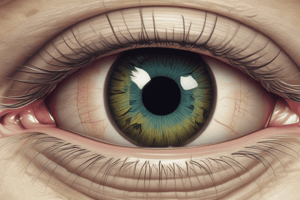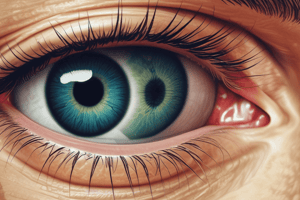Podcast
Questions and Answers
What does the term 'hill of vision' refer to in the context of visual fields?
What does the term 'hill of vision' refer to in the context of visual fields?
- The area that denotes the boundary of normal visual perception
- The maximum extent of vision in both eyes combined
- The overlapping areas of monocular fields in both eyes
- The graphical representation of visual field sensitivity (correct)
Which of the following is NOT a main method of perimetry?
Which of the following is NOT a main method of perimetry?
- Kinetic perimetry
- Static perimetry
- Dynamic perimetry (correct)
- Confrontation perimetry
What is the typical vertical extent of a normal monocular visual field?
What is the typical vertical extent of a normal monocular visual field?
- 160°
- 140°
- 120° (correct)
- 100°
Why is it crucial to evaluate the reliability of visual field data?
Why is it crucial to evaluate the reliability of visual field data?
What might a loss of field in the superior temporal quadrant suggest?
What might a loss of field in the superior temporal quadrant suggest?
Which of the following can potentially lead to errors during visual field assessment?
Which of the following can potentially lead to errors during visual field assessment?
What does the term 'monocular field' specifically reference?
What does the term 'monocular field' specifically reference?
Which of the following is NOT a typical application for visual field testing?
Which of the following is NOT a typical application for visual field testing?
What is the primary reason there is no vision in the blind spot?
What is the primary reason there is no vision in the blind spot?
How does the representation of the visual field in the striate cortex differ for the macula compared to the peripheral vision?
How does the representation of the visual field in the striate cortex differ for the macula compared to the peripheral vision?
What characterizes the fast threshold strategy compared to the full threshold test?
What characterizes the fast threshold strategy compared to the full threshold test?
What does the term 'retinotopic mapping' refer to?
What does the term 'retinotopic mapping' refer to?
Which statement best describes the staircase method?
Which statement best describes the staircase method?
What effect does a visual field defect have on the identification of lesions in the visual pathway?
What effect does a visual field defect have on the identification of lesions in the visual pathway?
In a supra-threshold test, how is the stimulus presented to the patient?
In a supra-threshold test, how is the stimulus presented to the patient?
What percentage of the cortex is informed by the central 30 degrees of vision?
What percentage of the cortex is informed by the central 30 degrees of vision?
What is the main advantage of using the fast threshold strategy over the full threshold test?
What is the main advantage of using the fast threshold strategy over the full threshold test?
Which of the following is NOT true about monocular vision?
Which of the following is NOT true about monocular vision?
What is the initial stimulus selection process for the fast threshold strategy?
What is the initial stimulus selection process for the fast threshold strategy?
When observing a field plot with a blind spot, where is it located?
When observing a field plot with a blind spot, where is it located?
What happens to the congruence of visual field defects as the pathway progresses towards the occipital cortex?
What happens to the congruence of visual field defects as the pathway progresses towards the occipital cortex?
What characteristic of pre-chiasmal lesions is typically observed?
What characteristic of pre-chiasmal lesions is typically observed?
What type of visual field defect is typical for chiasmal lesions?
What type of visual field defect is typical for chiasmal lesions?
What is a common outcome from lesions affecting the optic nerve?
What is a common outcome from lesions affecting the optic nerve?
Which statement best describes the defects associated with postchiasmatic lesions?
Which statement best describes the defects associated with postchiasmatic lesions?
What would you most likely observe in the optic nerves of someone with a pre-chiasmal lesion?
What would you most likely observe in the optic nerves of someone with a pre-chiasmal lesion?
Which of the following conditions is typically associated with chiasmal lesions?
Which of the following conditions is typically associated with chiasmal lesions?
What visual field defect pattern would typically present if there is a compressive lesion at the optic chiasm?
What visual field defect pattern would typically present if there is a compressive lesion at the optic chiasm?
What is the expected effect on the pupils when damage occurs in the optic pathway?
What is the expected effect on the pupils when damage occurs in the optic pathway?
What characteristic is associated with a post-chiasm visual defect?
What characteristic is associated with a post-chiasm visual defect?
Which statement accurately describes cortical visual defects?
Which statement accurately describes cortical visual defects?
What type of hemianopia is typically associated with a pituitary tumor?
What type of hemianopia is typically associated with a pituitary tumor?
Which of the following is a common cause of post-chiasm visual defects?
Which of the following is a common cause of post-chiasm visual defects?
What is true about the pupil light reflex in cases of optic nerve lesions?
What is true about the pupil light reflex in cases of optic nerve lesions?
What phenomenon describes the relative sensitivity of vision at various locations in the visual field?
What phenomenon describes the relative sensitivity of vision at various locations in the visual field?
Which of these statements accurately reflects the nature of a quadrantinopia?
Which of these statements accurately reflects the nature of a quadrantinopia?
What does 'macula sparing' refer to in the context of cortical defects?
What does 'macula sparing' refer to in the context of cortical defects?
What is a primary disadvantage of kinetic perimetry as described?
What is a primary disadvantage of kinetic perimetry as described?
In static automated perimetry, how are results typically recorded?
In static automated perimetry, how are results typically recorded?
Which parameter indicates the smallest, dimmest intensity in the grading system?
Which parameter indicates the smallest, dimmest intensity in the grading system?
What is one advantage of kinetic perimetry?
What is one advantage of kinetic perimetry?
How is a visual field result recorded when it is not full?
How is a visual field result recorded when it is not full?
What is the purpose of the frequency of seeing curve in perimetry?
What is the purpose of the frequency of seeing curve in perimetry?
Which technique in kinetic perimetry involves comparing the examiner's visual field with that of the patient?
Which technique in kinetic perimetry involves comparing the examiner's visual field with that of the patient?
What distinguishes static automated perimetry from kinetic perimetry?
What distinguishes static automated perimetry from kinetic perimetry?
Flashcards
Visual Field
Visual Field
The area a person can see with one eye while looking straight ahead.
Perimetry
Perimetry
Testing the extent and sensitivity of the visual field, often using specialized equipment.
Static Perimetry
Static Perimetry
A visual field test where the target is stationary and the patient is asked to indicate when they see it.
Kinetic Perimetry
Kinetic Perimetry
Signup and view all the flashcards
Confrontation
Confrontation
Signup and view all the flashcards
Visual Field Defect
Visual Field Defect
Signup and view all the flashcards
Normal Visual Field Extent
Normal Visual Field Extent
Signup and view all the flashcards
Determining Reliability
Determining Reliability
Signup and view all the flashcards
Blind Spot
Blind Spot
Signup and view all the flashcards
Optic Nerve
Optic Nerve
Signup and view all the flashcards
Visual Field Mapping
Visual Field Mapping
Signup and view all the flashcards
Optic Chiasm
Optic Chiasm
Signup and view all the flashcards
Optic Tract
Optic Tract
Signup and view all the flashcards
Visual Cortex (V1)
Visual Cortex (V1)
Signup and view all the flashcards
Visual Field Defect Localization
Visual Field Defect Localization
Signup and view all the flashcards
Pre-chiasmatic Lesion
Pre-chiasmatic Lesion
Signup and view all the flashcards
Chiasmatic Lesion
Chiasmatic Lesion
Signup and view all the flashcards
Post-chiasmatic Lesion
Post-chiasmatic Lesion
Signup and view all the flashcards
Bitemporal Hemianopia
Bitemporal Hemianopia
Signup and view all the flashcards
Junctional Scotoma
Junctional Scotoma
Signup and view all the flashcards
Relative Afferent Pupillary Defect (RAPD)
Relative Afferent Pupillary Defect (RAPD)
Signup and view all the flashcards
Vertical Midline Respecting
Vertical Midline Respecting
Signup and view all the flashcards
Horizontal Midline Respecting
Horizontal Midline Respecting
Signup and view all the flashcards
Gross Perimetry
Gross Perimetry
Signup and view all the flashcards
Threshold
Threshold
Signup and view all the flashcards
Frequency of Seeing Curve
Frequency of Seeing Curve
Signup and view all the flashcards
Goldmann Perimetry
Goldmann Perimetry
Signup and view all the flashcards
Threshold Algorithms
Threshold Algorithms
Signup and view all the flashcards
Homonymous Hemianopia
Homonymous Hemianopia
Signup and view all the flashcards
Quadrantanopia
Quadrantanopia
Signup and view all the flashcards
Macula Sparing
Macula Sparing
Signup and view all the flashcards
Accommodation
Accommodation
Signup and view all the flashcards
Pupil Light Reflex
Pupil Light Reflex
Signup and view all the flashcards
Full Threshold Test
Full Threshold Test
Signup and view all the flashcards
Supra-threshold Test
Supra-threshold Test
Signup and view all the flashcards
Staircase Method
Staircase Method
Signup and view all the flashcards
4-2dB Staircase Method
4-2dB Staircase Method
Signup and view all the flashcards
Sensitivity
Sensitivity
Signup and view all the flashcards
Study Notes
Nut-Free Zone
- Images show a "STOP NUT-FREE ZONE" sign
- Images also show various foods including candy bars and nuts.
- Images also show beauty products.
Lecture Recording
- Lecture recording is part of Plymouth University's Content Capture Project.
- Recording will be available via Panopto block on the module DLE pages.
- Students can ask questions during the lecture.
- Questions asked may appear on the recording.
- Students can ask to pause the recording if they don't want their questions recorded.
OPT505 Lecture 10: Introduction to Visual Fields
- The lecture is on visual fields, and is given by Ellie Livings.
- The presentation outlines the concepts of visual fields.
Intended Learning Outcomes
- Students will learn the terminology for describing visual fields and concepts like the "hill of vision."
- Students will apply knowledge of ocular anatomy and the visual pathway.
- Students will interpret visual field defects and identify potential lesion locations.
- Students will compare different perimetry techniques and visual field programs.
- Students will learn how to reduce visual field assessment errors.
- Students will interpret visual field plots and determine their reliability.
Fields: Overview
- Visual field is the area you can see, either with one eye (monocular) or two eyes (binocular).
- Visual fields are normally discussed monocularly unless in special cases.
- Visual field integrity reflects the overall health of the visual system.
- Testing is used for screening, diagnosis, localizing visual loss, and determining functional vision.
The Normal Field: Extent
- Normal monocular fields overlap.
- Normal visual fields include about 120° vertically and 160° horizontally.
- Blind spots are located temporally in field plots.
The Normal Field: The Blind Spot
- Blind spot is the area of the field occupied by the optic nerve.
- There's no vision in the blind spot.
- The blind spot is a useful landmark on visual field plots and is located temporally.
Visual Pathway
- Visual field defects help pinpoint lesions within the visual pathway.
- The visual pathway begins in the retina and progresses through the optic nerve, optic tract, lateral geniculate nucleus (LGN), optic radiations, and ends at the primary visual cortex.
- Visual pathway defects can occur along any segment of that pathway.
Visual Pathway: Chiasm
- Nasal fibers from each eye cross at the optic chiasm.
- Fibers from the left and right visual fields project to the same side of the brain.
- Fibers from the temporal side do not cross at the optic chiasm.
Visual Pathway: Topographic Organization in Striate Cortex
- Adjacent points in the visual field are mapped adjacently in the striate cortex, showing a one-to-one relationship
- The macula has more cortical representation in the striate cortex.
- Information about a central 30 degrees of vision occupies around 83% of the cortex.
What does this mean for the retinal fibres?
- Retinal fibre organization along the visual pathway impacts resulting visual field defects.
- Lesions affect visual field differently depending on their location.
- Examples of lesions and resulting visual defects in the visual field are mentioned.
Describing the Defect
- Visual field defects can be described based on their relationships to the horizontal and vertical midline.
- Common defect classifications are quadrantanopia, hemianopia, altitudinal defects, and scotomas.
- Comparison between the left and right visual fields are important for understanding the extent and location of a defect
Pre-chiasmal
- Visual problems in the pre-chiasmal segment, such as optic nerve disorders, glaucoma or trauma, lead to ipsilateral and monocular defects.
- Pupil function may be affected as part of the defect (e.g., afferent pupillary defect)
Chiasmal
- Visual problems in the chiasmal segment, like tumors at or near the crossing point, may result in binocular defects.
- Defects often involve both temporal visual fields (bitemporal hemianopsia).
Post-chiasmal
- Visual problems after the optic chiasm lead to a defect on the same side of both visual fields.
- Visual defects respect the vertical midline and are typically more congruent.
- Lesions can be stroke or tumor.
Pupilomotor fibres (mid-brain connections)
- Pupil light reflex is mediated by retinal ganglion cells projecting directly to the pretectum.
- Lesions in the optic nerve, chiasm, or tract cause loss of both visual perception and pupil light response.
Lesions along the visual pathway
- Visual pathway lesions affect visual field assessment according to their location.
- Visual deficits can be detected at any stage in the visual pathway, including prechiasmatic (before the optic chiasm), chiasmatic (at the optic chiasm), and postchiasmatic (after the optic chiasm).
Mapping the Field: Kinetic and Static Perimetry
- Kinetic perimetry maps visual field sensitivity using moving stimuli.
- Static perimetry uses stationary stimuli at various intensities to chart the visual field.
Kinetic perimetry: Types
- Bjerrum screen, Octopus 900, Goldmann bowl perimeter machines are commonly used machines (hardware) for kinetic perimetry tests with their specific uses and benefits in clinical practice.
Kinetic perimetry: Goldmann
- The Goldmann visual field test is the most common manual kinetic perimetry instrument.
- It uses calibrated stimuli on a bowl-shaped perimeter with variable intensity and size.
- Data interpretation is logarithmic and expressed as degrees or decibels.
Kinetic perimetry: Used when
- Used for suspected neurological visual field defects, especially large areas of absolute loss, and previous findings of unrepeatable tests.
Mapping the field: Kinetic perimetry
- Gross or confrontation visual fields tests are a type of kinetic perimetry test.
- This test involves comparing a patient's visual field with the examiner's own.
Static Automated perimetry
- Automated visual field testing uses programmed visual stimuli (usually light) presented at various points in the visual field.
- Results can be quantified in decibels (dB).
- Common methods include SITA.
Frequency of seeing curve
- The frequency of seeing curve plots the proportion of times a target is seen at different light intensities.
- 50% of the time is used to define a threshold.
Full threshold
- Full threshold tests (e.g., Humphrey visual field analyser) precisely measure the smallest stimulus (light) intensity to produce a successful response (detection).
Staircase method
- Staircase method is a specific technique used in threshold estimations in visual-field testing.
- It has particular properties for increasing and decreasing intensities.
Supra-threshold Test
- Supra-threshold testing evaluates a larger section of the visual field than standard threshold tests.
- By measuring the sensitivity to higher light intensities, this technique pinpoints the shape of the hill of vision.
Background learning
- The normal visual field, various instruments and strategies are detailed to provide a comprehensive background of the subject matter for study.
Factors influencing visual field measurements
- Visual field measurement is influenced by patient performance, stimulus type and the testing environment.
- Patient and testing factors are provided for the evaluation.
How bright is the light, how sensitive is the retina?
- Light intensity used in visual field testing is measured using apostilbs as the absolute units of light intensity to assess retinal sensitivity.
- Logarithmic scales (e.g., decibels with a scale of 0-40dB) are used to measure the intensity.
Mapping the field
- The shape and features of the visual field are analysed through different techniques with varying advantages and disadvantages.
Studying That Suits You
Use AI to generate personalized quizzes and flashcards to suit your learning preferences.




